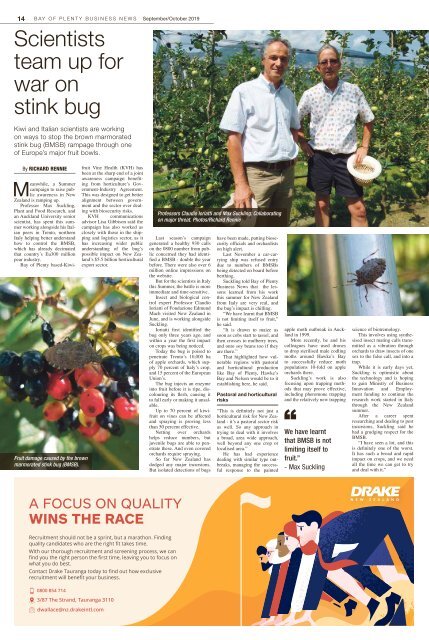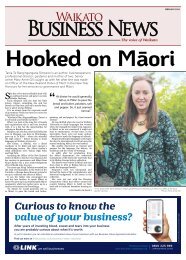Bay of Plenty Business News September/October 2019
From mid-2016 Bay of Plenty businesses have a new voice, Bay of Plenty Business News. This new publication reflects the region’s growth and importance as part of the wider central North Island economy.
From mid-2016 Bay of Plenty businesses have a new voice, Bay of Plenty Business News. This new publication reflects the region’s growth and importance as part of the wider central North Island economy.
Create successful ePaper yourself
Turn your PDF publications into a flip-book with our unique Google optimized e-Paper software.
14 BAY OF PLENTY BUSINESS NEWS <strong>September</strong>/<strong>October</strong> <strong>2019</strong><br />
Scientists<br />
team up for<br />
war on<br />
stink bug<br />
Kiwi and Italian scientists are working<br />
on ways to stop the brown marmorated<br />
stink bug (BMSB) rampage through one<br />
<strong>of</strong> Europe’s major fruit bowls.<br />
By RICHARD RENNIE<br />
Fruit damage caused by the brown<br />
marmorated stink bug (BMSB).<br />
Meanwhile, a Summer<br />
campaign to raise public<br />
awareness in New<br />
Zealand is ramping up.<br />
Pr<strong>of</strong>essor Max Suckling,<br />
Plant and Food Research, and<br />
an Auckland University senior<br />
scientist, has spent this summer<br />
working alongside his Italian<br />
peers in Trento, northern<br />
Italy helping better understand<br />
how to control the BMSB,<br />
which has already decimated<br />
that country’s Eu300 million<br />
pear industry.<br />
<strong>Bay</strong> <strong>of</strong> <strong>Plenty</strong> based-Kiwifruit<br />
Vine Health (KVH) has<br />
been at the sharp end <strong>of</strong> a joint<br />
awareness campaign benefiting<br />
from horticulture’s Government-Industry<br />
Agreement.<br />
This was designed to get better<br />
alignment between government<br />
and the sector over dealing<br />
with biosecurity risks.<br />
KVH communications<br />
advisor Lisa Gibbison said the<br />
campaign has also worked as<br />
closely with those in the shipping<br />
and logistics sector, as it<br />
has increasing wider public<br />
understanding <strong>of</strong> the bug’s<br />
possible impact on New Zealand’s<br />
$5.5 billion horticultural<br />
export sector.<br />
Pr<strong>of</strong>essors Claudio Ioriatti and Max Suckling: Collaborating<br />
on major threat. Photos/Richard Rennie<br />
Last season’s campaign<br />
generated a healthy 930 calls<br />
on the 0800 number from public<br />
concerned they had identified<br />
a BMSB - double the year<br />
before. There were also over 6<br />
million online impressions on<br />
the website.<br />
But for the scientists in Italy<br />
this Summer, the battle is more<br />
immediate and time-sensitive.<br />
Insect and biological control<br />
expert Pr<strong>of</strong>essor Claudio<br />
Ioriatti <strong>of</strong> Fondazione Edmund<br />
Mach visited New Zealand in<br />
June, and is working alongside<br />
Suckling.<br />
Ioriatti first identified the<br />
bug only three years ago, and<br />
within a year the first impact<br />
on crops was being noticed.<br />
Today the bug is poised to<br />
penetrate Trento’s 10,000 ha<br />
<strong>of</strong> apple orchards, which supply<br />
70 percent <strong>of</strong> Italy’s crop,<br />
and 15 percent <strong>of</strong> the European<br />
Union’s.<br />
The bug injects an enzyme<br />
into fruit before it is ripe, discolouring<br />
its flesh, causing it<br />
to fall early or making it unsalable.<br />
Up to 70 percent <strong>of</strong> kiwifruit<br />
on vines can be affected<br />
and spraying is proving less<br />
than 50 percent effective.<br />
Netting over orchards<br />
helps reduce numbers, but<br />
juvenile bugs are able to penetrate<br />
these. And even covered<br />
orchards require spraying.<br />
So far New Zealand has<br />
dodged any major incursions.<br />
But isolated detections <strong>of</strong> bugs<br />
have been made, putting biosecurity<br />
<strong>of</strong>ficials and orchardists<br />
on high alert.<br />
Last November a car-carrying<br />
ship was refused entry<br />
due to numbers <strong>of</strong> BMSBs<br />
being detected on board before<br />
berthing.<br />
Suckling told <strong>Bay</strong> <strong>of</strong> <strong>Plenty</strong><br />
<strong>Business</strong> <strong>News</strong> that the lessons<br />
learned from his work<br />
this summer for New Zealand<br />
from Italy are very real, and<br />
the bug’s impact is chilling.<br />
“We have learnt that BMSB<br />
is not limiting itself to fruit,”<br />
he said.<br />
“It is drawn to maize as<br />
soon as cobs start to tassel, and<br />
then crosses to mulberry trees,<br />
and onto soy beans too if they<br />
are there.”<br />
That highlighted how vulnerable<br />
regions with pastoral<br />
and horticultural production<br />
like <strong>Bay</strong> <strong>of</strong> <strong>Plenty</strong>, Hawke’s<br />
<strong>Bay</strong> and Nelson would be to it<br />
establishing here, he said.<br />
Pastoral and horticultural<br />
risks<br />
“This is definitely not just a<br />
horticultural risk for New Zealand<br />
- it’s a pastoral sector risk<br />
as well. So any approach in<br />
trying to deal with it involves<br />
a broad, area wide approach,<br />
well beyond any one crop or<br />
localised area.”<br />
He has had experience<br />
dealing with similar type outbreaks,<br />
managing the successful<br />
response to the painted<br />
apple moth outbreak in Auckland<br />
in 1999.<br />
More recently, he and his<br />
colleagues have used drones<br />
to drop sterilised male codling<br />
moths around Hawke’s <strong>Bay</strong><br />
to successfully reduce moth<br />
populations 10-fold on apple<br />
orchards there.<br />
Suckling’s work is also<br />
focusing upon trapping methods<br />
that may prove effective,<br />
including pheromone trapping<br />
and the relatively new trapping<br />
We have learnt<br />
that BMSB is not<br />
limiting itself to<br />
fruit.”<br />
- Max Suckling<br />
science <strong>of</strong> biotremology.<br />
This involves using synthesised<br />
insect mating calls transmitted<br />
as a vibration through<br />
orchards to draw insects <strong>of</strong> one<br />
sex to the false call, and into a<br />
trap.<br />
While it is early days yet,<br />
Suckling is optimistic about<br />
the technology and is hoping<br />
to gain Ministry <strong>of</strong> <strong>Business</strong><br />
Innovation and Employment<br />
funding to continue the<br />
research work started in Italy<br />
through the New Zealand<br />
summer.<br />
After a career spent<br />
researching and dealing to pest<br />
incursions, Suckling said he<br />
had a grudging respect for the<br />
BMSB.<br />
“I have seen a lot, and this<br />
is definitely one <strong>of</strong> the worst.<br />
It has such a broad and rapid<br />
impact on crops, and we need<br />
all the time we can get to try<br />
and deal with it.”


















